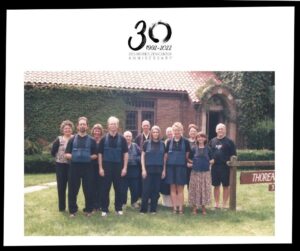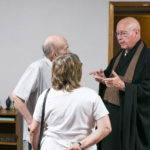History
The Des Moines Zen Center (DMZC) was established by a small group of individuals with interest in Zen thought and writings, drawn to the awakening offered through zazen sitting meditation, and seeking the support of community, sangha.
On Palm Sunday 1992, Rev. Nonin Chowaney, late Abbot of the Nebraska Zen Center, gave a presentation at a Des Moines church that marked the inception of the DMZC. Soon thereafter weekly meetings began at theThoreau Center on Kingman Boulevard, sitting zazen, following Soto Zen practices as carried to the West from Japan. Those earliest sittings In The Thoreau Center’s community room included an “altar” and supplies stored in a shoebox between meetings, cushion carried back and forth.
In 1998, Shoken Winecoff Roshi, then of Decorah Zen Center, now abbot of Ryumonji Zen Monastery near Decorah, and Rev. Zuiko Redding of the Cedar Rapids Zen Center began visits to Des Moines to instruct sangha members in preparation for Jukai, lay ordination. Zuiko-san oversaw the sewing of rakusu, a small patchwork neckpiece, symbolic of the Buddha’s and priest’s robes, sown by the student as a mindfulness practice, opportunity for wholehearted attention to this very moment, the heart of zazen. On August 22, 1999, Rev. Winecoff, assisted by Rev. Redding and Jikan Kondrick, administered our first Jukai ceremony. Five members
began the process of “living in vow” with recitation of the sixteen Bodhisattva precepts and the verses of Formless Repentance as well as bestowal of Rakusu.
As the Des Moines sangha grew, the Center migrated from the Thoreau Center through a series of rented sites. First to a Drake area apartment (2001), next a basement space South of Grand (2010), followed by a 35th St storefront (2013), finally purchasing the current site in 2018. In 2002, DSM ZC adopted bylaws, defined organizational structure, and incorporated as a 501(c)(3) nonprofit religious organization. DMZC holds deep affiliation with Shoken Winecoff Roshi and Ryumonji Monastery with members going there to study and practice under Shoken-san, attend sesshins and angos (three month retreats).
Rev. Eido Espe, assumed the mantle of DMZC’s first head priest following dharma transmission from Rev. Shoken Winecoff in 2010. During his tenure (2010-2023), Eido-san ordained Rev. Eishin Houghton and Rev. Gendo Thornberry, oversaw the acquisition of our current site and stewarded the several year pursuit of temple recognition.
Deep River Temple, Shinsenji, received designation by Sotoshu, the international Soto Zen Mission, on May 19, 2021, establishing Des Moines Zen Center’s home temple. Sotoshu offered the prayer that our temple continue to develop within the doctrines and rituals of Soto Zen.
Rev Eishin Houghton, having received dharma transmission in 2022 from Eido, rose to the role of Deep River Temple head priest in April 2023. Eido then transitioned to emeritus priest.
Zen’s path to Des Moines DMZC and its home Shinsenji, Deep River Temple live within the nearly 2,600 year-old tradition of Shakyamuni Buddha’s awakening. At about 60 to
100 years old, depending on how you measure, American Zen is quite young, only now entering its third generation.
Siddartha Gautama Shakymuni was born a prince in northern India, what is now Nepal, around 560 BCE. His mother soon died soon and his bereft father thereafter provided his every want, hoping to hide from him every sorrow. Yet Siddartha found this sequestered life dissatisfying and as a young man left the palace where he first encountered a sick person, an old person, and a dying person. Deeply aggrieved upon seeing the reality of life’s suffering, he left his home and family, seeking the end of suffering for himself and all others. After pursuing and then rejecting various ascetic practices, Shakyamuni ultimately took his seat beneath the Bodhi Tree
resolving not to arise until enlightened. After a prolonged period of silent sitting, gazing upon the morning star, touching the earth as his witness, Shakyamuni declared his enlightenment, “I and all sentient beings have together awakened!” and arose The Buddha (one who has awakened.)
For the next fifty years until his death, Buddha offered Dharma teaching including The Four Noble Truths, The Eightfold Path and many others, all to reveal our innate wisdom of selflessness and compassion.
On one occasion The Buddha held up a flower, blinked, and wordlessly delivered his Flower Sermon. Among the many in audience, only his disciple Mahakasyapa understood and smiled. The Buddha declared, “I have the Treasury of the True Dharma Eye and Wonderous Mind of
Nirvana, and I transmit it to Mahakasyapa.” With this mind-to-mind transmission, Mahakasyapa became Zen’s first patriarch. The dharma seed of Zen thus planted, germinated and spread. In the 6th century Bodhidharma, our twenty-eighth patriarch, transmitted the dharma from India to China, where it became Chan (the Chinese forbearer of Zen), and in the 13th century, Japanese monk Eihei Dogen, tramsnitted it from China to Japan, founding the Japanese Soto Zen school. Spreading also to southeast Asia and now the West, many schools and sects of Buddhism have arisen, each with their own emphases variously focused upon devotional practices, sutra (scripture) study and/or meditative practices.
The DMZC follows Dogen Zenji’s Soto Zen tradition, placing greatest emphasis upon zazen (“sitting meditation”), also known as shikantaza (“just sitting”), rooted in Buddha’s original practice, taking his seat with resolute calm awareness, that led to his awakening, Eastern peoples and thought migration to the West began in the late 19th Century. Cultural exchange slowly grew and by the mid-20th Century interest in Zen thought and practices grew beyond Asian communities.
The Japanese priest/monk Shunryu Suzuki quietly arrived in San Francisco in 1959 assuming priest’s duties at Sokoji, Soto Zen Mission, founded 1934 serving the Japanese community. Under Suzuki’s leadership the number of Westerners visiting Sokoji grew dramatically, overwhelming the facility, leading to the founding of San Francisco Zen Center in 1962 and Tassajara Zen Mountain Center in 1967, Soto Zen’s first monastic training center
outside Japan.
In 1966 Dainin Katagiri, another Japanese priest/monk, joined Suzuki to assist in teaching this rapidly growing sangha (community of Buddhist practitioners). Following Suzuki Roshi’s death, Katagiri migrated to Minneapolis in 1972, establishing Zen Meditation Center of Minnesota and
later Hokyoji rural practice site in southeastern Minnesota. Though passing from this life March 1, 1990, Katagiri shall always remain a seminal figure in the 20th century transmission of Soto Zen to the West, his reach remaining deep and wide. Several of his dharma heirs (priests bestowed dharma transmission) have remained in the Midwest, four of which have contributed
directly to nurturing the Des Moines Zen Center. It is in Dainin Katagiri’s lineage that DMZC securely rests.
The Des Moines Zen Center has also benefited greatly from a number of noteworthy visiting priests. Initially, several DMZC members traveled to Omaha to participate in sesshins with Nonin-san. He later came to Des Moines to lead sesshin, as did Daiyu Klumpf, student of Harada Roshi, Dokai Georgesen, guiding teacher at Hokyoji Zen Practice Community in Eitzen, Minn, Rev.Teijo Munnich, Abbess of Great Tree Zen Temple in Alexander, N Carolina, the late Rev. Jikan Kondrick, and, of course, Shoken Winecoff Roshi, Abbot of Ryumonji. Most of these priests either studied with or are dharma heirs of Dainin Katagiri.
We’ve also been fortunate to host monks and priests visiting from Japan, particularly Rev Shohaku Okumura early in his U.S. residency. Shohaku-san is dharma heir of Kosho Uchiyama roshi, late abbot of Antaiji Monastery in Japan, one of the foremost Zen masters of the 20th century.
Shohaku is himself a highly respected teacher, scholar and translator, with special focus on the writings of Uchiyama and Eihei Dogen, founder of Soto Zen. Our early sesshin with Shohaku-san was memorable in its rigor and his kind support.
In 2022, Des Moines Zen Center celebrated its 30th year of practice. The pursuit of suchness remains ongoing.



